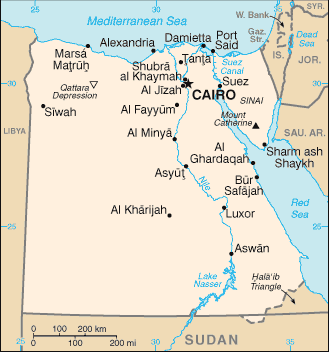Arab Republic of Egypt
Related Categories:
 Egyptian Symbols
Egyptian SymbolsAnkh, pyramid, and other symbols of Egypt.
www.the-symbols.net/
The first national flag of modern Egypt was established by a Royal Decree in 1923 after Egypt gained conditional independence from Great Britain in 1922.
www.fotw.us/flags/eg.html Egypt - wikipedia.org
Egypt is famous for its ancient civilization and some of the world's most ancient and important monuments, including the Giza Pyramids and the Great Sphinx of Giza; the southern city of Luxor contains a particularly large number of ancient artifacts such as the Karnak Temple and the Valley of the Kings.
en.wikipedia.org/
Egypt is the most populous country in the Arab world and the second-most populous on the African Continent. Nearly all of the country's 79 million people live in Cairo and Alexandria; elsewhere on the banks of the Nile; in the Nile delta, which fans out north of Cairo; and along the Suez Canal. These regions are among the world's most densely populated, containing an average of over 3,820 persons per square mile (1,540 per sq. km.), as compared to 181 persons per sq. mi. for the country as a whole.
Small communities spread throughout the desert regions of Egypt are clustered around oases and historic trade and transportation routes. The government has tried with mixed success to encourage migration to newly irrigated land reclaimed from the desert. However, the proportion of the population living in rural areas has continued to decrease as people move to the cities in search of employment and a higher standard of living.
The Egyptians are a fairly homogeneous people of Hamitic origin. Mediterranean and Arab influences appear in the north, and there is some mixing in the south with the Nubians of northern Sudan. Ethnic minorities include a small number of Bedouin Arab nomads in the eastern and western deserts and in the Sinai, as well as some 50,000-100,000 Nubians clustered along the Nile in Upper (southern) Egypt.
The literacy rate is about 58% of the adult population. Education is free through university and compulsory from ages six through 15. Rates for primary and secondary education have strengthened in recent years. Ninety-three percent of children enter primary school today, compared with 87% in 1994. Major universities include Cairo University (100,000 students), Alexandria University, and the 1,000-year-old Al-Azhar University, one of the world's major centers of Islamic learning.
Egypt's vast and rich literature constitutes an important cultural element in the life of the country and in the Arab world as a whole. Egyptian novelists and poets were among the first to experiment with modern styles of Arabic literature, and the forms they developed have been widely imitated. Egyptian novelist Naguib Mahfouz was the first Arab to win the Nobel prize for literature. Egyptian books and films are available throughout the Middle East.
Egypt has endured as a unified state for more than 5,000 years, and archeological evidence indicates that a developed Egyptian society has existed for much longer. Egyptians take pride in their "pharaonic heritage" and in their descent from what they consider mankind's earliest civilization. The Arabic word for Egypt is Misr, which originally connoted "civilization" or "metropolis."
Archeological findings show that primitive tribes lived along the Nile long before the dynastic history of the pharaohs began. By 6000 B.C., organized agriculture had appeared.
In about 3100 B.C., Egypt was united under a ruler known as Mena, or Menes, who inaugurated the 30 pharaonic dynasties into which Egypt's ancient history is divided--the Old and the Middle Kingdoms and the New Empire. The pyramids at Giza (near Cairo), which were built in the fourth dynasty, testify to the power of the pharaonic religion and state. The Great Pyramid, the tomb of Pharaoh Khufu (also known as Cheops), is the only surviving monument of the Seven Wonders of the Ancient World. Ancient Egypt reached the peak of its power, wealth, and territorial extent in the period called the New Empire (1567-1085 B.C.).
www.state.gov/r/
Introduction
About
Contact
Symbols in The News
Interpret this Symbol
AAC
African
AI
Alchemy
Alphabets
Ancient
Animal Symbolism
Architecture
Art
Articles
Astrology
Baha'i
Blissymbolics
Blueprint Symbols
Buddhist
Celtic Symbols
Cemetery
Chinese Symbols
Christian
Circle
City
Codes
Color
Conlangs
Crop Circles
Danger
Da Vinci Code
Designing Logos
Dictionaries
Dreams
Education
Egyptian Symbols
Electrical
Emoticons
Find Images
Fonts
Food
Fraternity
Hamsa
Healing
Heraldry
Hermetic
Highway Signs
Hindu
History
Hobo
Holiday
Icons
iConji
Islamic
Jain Symbols
Japanese, Kanji
Jewish
Justice
Law
Literary Symbolism
Mandalas
Map
Masonic
Math, Number
Meaning of Names
Medical
Middle East
Military
Miscellaneous
Money
Music
Mythology
Native American
Playing Cards
Power
Psychology
QiQiiKhu
Reiki
Religious
Runes, Norse
Sacred Geometry
Scientific
Science Fiction
Sorority
Sports
Symbols in the News
Tattoos
ThirteenSymbols
Tree of Life
Ursprache
Videos
Visual Languages
Weather
Web Codes
Wicca
Words
Writing Systems
Braille
Coinherence
Coptic
Cuneiform
Easter Island
Etruscan
Happy Human
Hebrew
Kokopelli
Linear B
Lotus
Love Symbols
Mandorla
Moon Alphabet
Nine Pointed Star
Om
Oz
Phonetic
Scarab Beetle
Silent
Theosophy
Unifon
About
Contact
Symbols in The News
Interpret this Symbol
AAC
African
AI
Alchemy
Alphabets
Ancient
Animal Symbolism
Architecture
Art
Articles
Astrology
Baha'i
Blissymbolics
Blueprint Symbols
Buddhist
Celtic Symbols
Cemetery
Chinese Symbols
Christian
Circle
City
Codes
Color
Conlangs
Crop Circles
Danger
Da Vinci Code
Designing Logos
Dictionaries
Dreams
Education
Egyptian Symbols
Electrical
Emoticons
Find Images
Fonts
Food
Fraternity
Hamsa
Healing
Heraldry
Hermetic
Highway Signs
Hindu
History
Hobo
Holiday
Icons
iConji
Islamic
Jain Symbols
Japanese, Kanji
Jewish
Justice
Law
Literary Symbolism
Mandalas
Map
Masonic
Math, Number
Meaning of Names
Medical
Middle East
Military
Miscellaneous
Money
Music
Mythology
Native American
Playing Cards
Power
Psychology
QiQiiKhu
Reiki
Religious
Runes, Norse
Sacred Geometry
Scientific
Science Fiction
Sorority
Sports
Symbols in the News
Tattoos
ThirteenSymbols
Tree of Life
Ursprache
Videos
Visual Languages
Weather
Web Codes
Wicca
Words
Writing Systems
Braille
Coinherence
Coptic
Cuneiform
Easter Island
Etruscan
Happy Human
Hebrew
Kokopelli
Linear B
Lotus
Love Symbols
Mandorla
Moon Alphabet
Nine Pointed Star
Om
Oz
Phonetic
Scarab Beetle
Silent
Theosophy
Unifon

